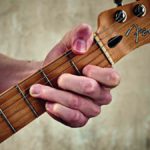One way to quickly change the key signature of your guitar without altering the shape of your fingers is using a capo. Capos are widespread and very instrumental for acoustic and electric guitars. How about a bass guitarist? Can you use a guitar capo on bass?
Let’s find out!
What’s a Guitar Capo?
A capo is a simple tiny piece of device that a guitarist uses to clamp a fret on the board of the guitar. It’s either of plastic or metal material. The effect of a capo is to reduce the playable length of a string and so gives easy transposing to diverse keys.

Why Are Capos Not Common on Bass Guitars?
If you dig deep you’ll notice that capos are widespread on electric and acoustic guitars. That’s because in playing the two, you employ chords. A capo hence becomes instrumental in transposing an open string chord to a different key signature.
A bass guitar on the other hand mostly blends with the drums in defining the rhythm. And hence a bass guitarist often plays single notes. So most often it doesn’t call for the use of a capo.
But Can You Use a Guitar Capo on Bass?
Yes, capos are common on acoustic and electric guitars. But does that mean you can’t use it on bass guitars? There are a couple of instances when you can use a guitar capo on bass.
Read on to find out those applications!
Reasons to Use a Guitar Capo on Bass
The manner of playing bass guitar often makes a capo unnecessary. But below are pretty reasons to use a capo:
Getting Creative with Chords
The resonating tone of the bass guitars often presents complete satisfaction to most listeners. But it doesn’t limit you from getting creative with chords. Some renowned brands have employed creativity with bass chords and charmed their listeners.
For instance, plucking or strumming two string chords can add a unique taste to music. And so it gives you a distinctive identity with your piece. In that case, a capo becomes vital. When you skillfully employ bass chords on a section of a piece of music the effect is charming.
Also Check Out – Essential Guitar Accessories Guide
Easy Playing
When the piece of music you are playing requires you to concentrate on the upper part of the fretboard it becomes easy to execute. But most songs require you to swap between playing notes that sometimes are even more than octave apart. In that case, you have to transverse several frets.
Think of moving your fingers back and forth across four frets on the bass guitar when playing a fast-paced song. That can be demanding especially if you aren’t a pro or possess small hands.
Attaching the right kind of capo on the upper fret can make switching to play between high and low notes less challenging.
Tapping on the Sound of Open Strings
An open stringed note produces a sound that is slightly different from that of a fretted note of the corresponding pitch. The difference becomes more distinctive when the open note registers prolonged ringing.
The effect of the two results in a multilayered rich pleasant sound. A capo makes it easier to produce such a rich taste of sound.
Makes Executing Advanced Techniques Easier
A professional guitarist finds it at ease to play simple to advanced techniques. However some people especially inexperienced guitarists find it challenging to execute legato runs, sweep picking, or arpeggios.
And that’s where the use of a capo comes in. Incorporating a guitar capo on the upper part of the fret makes the techniques easier to effect. That’s because your fingers then have to travel over a shorter distance than before.

Important Considerations When Using a Guitar Capo on Bass
Take Note of the Tune Before and After Incorporating the Capo
A guitar capo increases the pressure on strings. And so sometimes that may cause the guitar to stray from the desired tune.
Therefore take note of the tune before and after incorporating the guitar capo on bass, retune as necessary. For that reason consider using Boss TU-3 Chromatic Tuner. And when making the adjustments, ensure each string resonates freely.
Get the Fit of the Capo Right
Ideally, the capo should present a snug and tight fit on the guitar. Otherwise, it may strain the guitar neck. Position the capo such that the hinge face the ceiling while the cushion lays comfortably over the guitar strings.
That way any of the strings produces a clear sweet sound. If not, then readjust as necessary.
Related Article – Can You Use a Guitar Capo on a Ukulele?
Follow the Score on the Position of the Capo
When learning a new song from either tablature or scoresheets, often you’ll find the position of the capo indicated. Take note of what it says on capo on bass and its preferred position.
Final Remarks
Most often you don’t need a guitar capo on bass. But there are cases when it becomes vital. A capo on the bass allows your fingers to travel over a short distance or stay almost in the same position.
Besides, the tonal change that comes from the open strings when you transpose to a higher key signature fascinates some people.
So as you have perhaps realized even as a bassist, it’s necessary to keep a capo in your accessory bag.
‘LinkConnector Validation’




 Sign up to receive a free ebook: Master The Guitar in 7 days! (available for a limited period)
Sign up to receive a free ebook: Master The Guitar in 7 days! (available for a limited period)